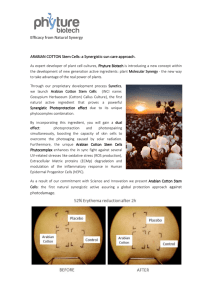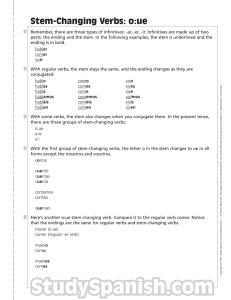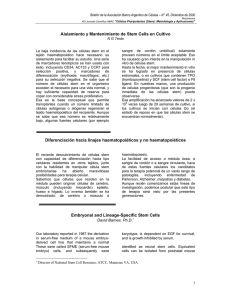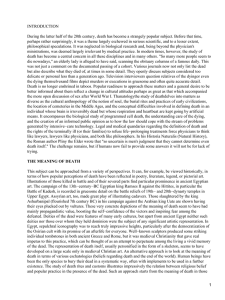Derivation of HVR1, HVR2 and HVR3 human
Anuncio
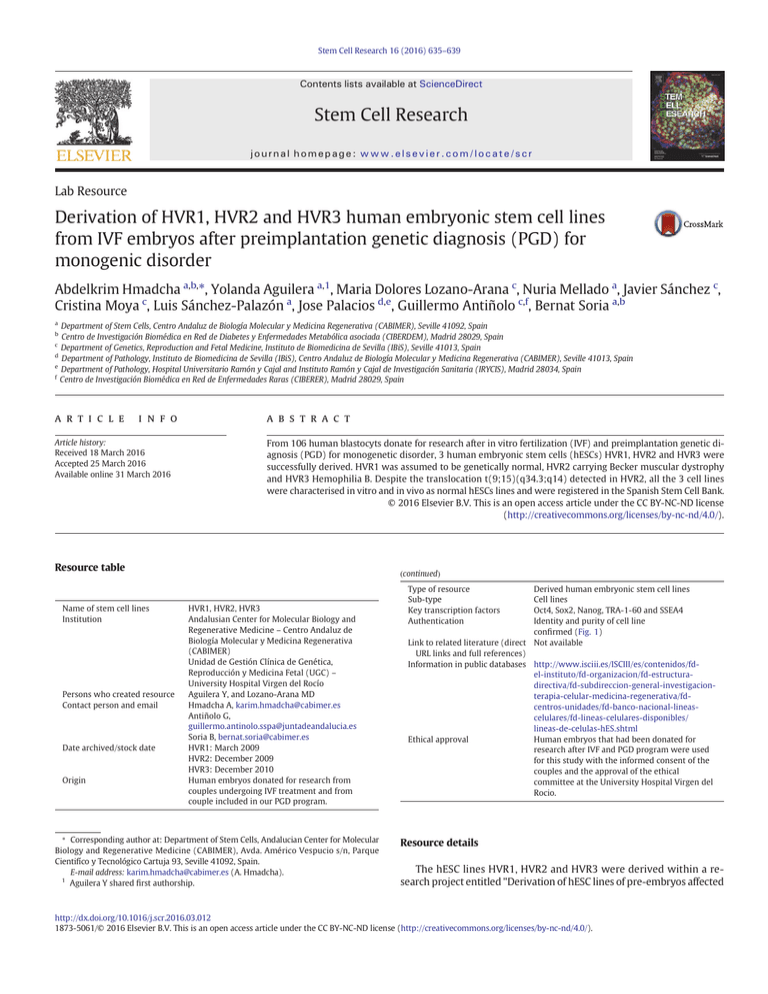
Stem Cell Research 16 (2016) 635–639 Contents lists available at ScienceDirect Stem Cell Research journal homepage: www.elsevier.com/locate/scr Lab Resource Derivation of HVR1, HVR2 and HVR3 human embryonic stem cell lines from IVF embryos after preimplantation genetic diagnosis (PGD) for monogenic disorder Abdelkrim Hmadcha a,b,⁎, Yolanda Aguilera a,1, Maria Dolores Lozano-Arana c, Nuria Mellado a, Javier Sánchez c, Cristina Moya c, Luis Sánchez-Palazón a, Jose Palacios d,e, Guillermo Antiñolo c,f, Bernat Soria a,b a Department of Stem Cells, Centro Andaluz de Biología Molecular y Medicina Regenerativa (CABIMER), Seville 41092, Spain Centro de Investigación Biomédica en Red de Diabetes y Enfermedades Metabólica asociada (CIBERDEM), Madrid 28029, Spain c Department of Genetics, Reproduction and Fetal Medicine, Instituto de Biomedicina de Sevilla (IBiS), Seville 41013, Spain d Department of Pathology, Instituto de Biomedicina de Sevilla (IBiS), Centro Andaluz de Biología Molecular y Medicina Regenerativa (CABIMER), Seville 41013, Spain e Department of Pathology, Hospital Universitario Ramón y Cajal and Instituto Ramón y Cajal de Investigación Sanitaria (IRYCIS), Madrid 28034, Spain f Centro de Investigación Biomédica en Red de Enfermedades Raras (CIBERER), Madrid 28029, Spain b a r t i c l e i n f o Article history: Received 18 March 2016 Accepted 25 March 2016 Available online 31 March 2016 a b s t r a c t From 106 human blastocyts donate for research after in vitro fertilization (IVF) and preimplantation genetic diagnosis (PGD) for monogenetic disorder, 3 human embryonic stem cells (hESCs) HVR1, HVR2 and HVR3 were successfully derived. HVR1 was assumed to be genetically normal, HVR2 carrying Becker muscular dystrophy and HVR3 Hemophilia B. Despite the translocation t(9;15)(q34.3;q14) detected in HVR2, all the 3 cell lines were characterised in vitro and in vivo as normal hESCs lines and were registered in the Spanish Stem Cell Bank. © 2016 Elsevier B.V. This is an open access article under the CC BY-NC-ND license (http://creativecommons.org/licenses/by-nc-nd/4.0/). Resource table Name of stem cell lines Institution Persons who created resource Contact person and email Date archived/stock date Origin (continued) HVR1, HVR2, HVR3 Andalusian Center for Molecular Biology and Regenerative Medicine – Centro Andaluz de Biología Molecular y Medicina Regenerativa (CABIMER) Unidad de Gestión Clínica de Genética, Reproducción y Medicina Fetal (UGC) – University Hospital Virgen del Rocío Aguilera Y, and Lozano-Arana MD Hmadcha A, karim.hmadcha@cabimer.es Antiñolo G, guillermo.antinolo.sspa@juntadeandalucia.es Soria B, bernat.soria@cabimer.es HVR1: March 2009 HVR2: December 2009 HVR3: December 2010 Human embryos donated for research from couples undergoing IVF treatment and from couple included in our PGD program. ⁎ Corresponding author at: Department of Stem Cells, Andalucian Center for Molecular Biology and Regenerative Medicine (CABIMER), Avda. Américo Vespucio s/n, Parque Cientifíco y Tecnológico Cartuja 93, Seville 41092, Spain. E-mail address: karim.hmadcha@cabimer.es (A. Hmadcha). 1 Aguilera Y shared first authorship. Type of resource Sub-type Key transcription factors Authentication Derived human embryonic stem cell lines Cell lines Oct4, Sox2, Nanog, TRA-1-60 and SSEA4 Identity and purity of cell line confirmed (Fig. 1) Link to related literature (direct Not available URL links and full references) Information in public databases http://www.isciii.es/ISCIII/es/contenidos/fdel-instituto/fd-organizacion/fd-estructuradirectiva/fd-subdireccion-general-investigacionterapia-celular-medicina-regenerativa/fdcentros-unidades/fd-banco-nacional-lineascelulares/fd-lineas-celulares-disponibles/ lineas-de-celulas-hES.shtml Ethical approval Human embryos that had been donated for research after IVF and PGD program were used for this study with the informed consent of the couples and the approval of the ethical committee at the University Hospital Virgen del Rocio. Resource details The hESC lines HVR1, HVR2 and HVR3 were derived within a research project entitled "Derivation of hESC lines of pre-embryos affected http://dx.doi.org/10.1016/j.scr.2016.03.012 1873-5061/© 2016 Elsevier B.V. This is an open access article under the CC BY-NC-ND license (http://creativecommons.org/licenses/by-nc-nd/4.0/). 636 A. Hmadcha et al. / Stem Cell Research 16 (2016) 635–639 by genetic diseases obtained after PGD", after approval from the Regional Commission Clinical Research Ethics Board of the Health Ministry of Junta de Andalucía (Inf. No. 4/07). A total of 9 embryos from in vitro fertilization (IVF) and 97 embryos from preimplantation genetic diagnosis (PGD) were donated for research in accordance with the legal requirements of the country of origin by donors included in PGD program at Unidad de Gestión Clínica de Genética, Reproducción y Medicina Fetal (UGC) from University Hospital Virgen del Rocío. The donors gave written informed consent (Cortes JL et al., 2007 and Fernández et al., 2014). We were able to derive 3 embryonic stem cell (hESC) lines (HVR1, HVR2 and HVR3). The HVR1 was derived from human embryo donated for research from a healthy couple undergoing IVF treatment; HVR2 and HVR3 from human embryo donated for research from a couple included in our PGD program for Becker muscular dystrophy for Hemophilia A respectively. Human embryos were thawed using Thaw Kit 1TM de Vitrolife® and cultured using G2 medium (GIII series, Vitrolife®), inner cell mass (ICM) was mechanically isolated under stereomicroscope using 2 insulin syringe (25G) at “hatching blastocyst” stage (Ström et al., 2007) and plated onto mitomycin-C inactivated human newborn foreskin fibroblasts (hFFs), the resulting colonies displayed the typical morphology of hESCs (Fig. 1A) and are positive to alkaline phosphatase staining (Fig. 1B). The analysis of pluripotent markers was evaluated by RT–PCR, immunofluorescence and flow cytometry. Undifferentiated HVR1, HVR2 Fig. 1. Characterization of the HVR1, HVR2 and HVR3 cell lines. A) ICMs from HVR1, HVR2 and HVR3 after 12 days in culture and HVR3 ICM after 8 days in culture on human newborn fibroblast feeder cells (hFFs). Representative bright-field of human embryonic stem cells (hESCs) colonies cultured on hFFs (bottom). B) HVR1, HVR2 and HVR3, cultured on hFFs (top) or on BD Matrigel™ (bottom), are positive for alkaline phosphatase staining. Scale bar: 200 μm. C) RT-PCR analysis of Oct4, Sox2, Nanog and TERT genes expression in undifferentiated hESC lines HVR1, HVR2 and HVR3. β-actin was used as control. D) Immunofluorescence detection of OCT4, SSEA4, TRA-1-60 and TRA-1-81 expression in HVR1, HVR2 and HVR3 cell line, nuclei were stained with Hoechst 33342. The scale bar: 50 μm. E) Flow cytometry analysis indicating the expression of SSEA4 and HLA-ABC markers (red histograms). Blue histograms indicate cells labelled with fluorescent-conjugated isotype-matched antibodies. A. Hmadcha et al. / Stem Cell Research 16 (2016) 635–639 637 karyotype with chromosome translocation 46,XY, t(9;15)(q34.3;q14) (Fig. 3C); this translocation has been also detected with FISH analysis (Fig. 3D). HVR1, HVR2 and HVR3 were successfully cultured in feeder-free culture conditions (on Matrigel™) and maintained in culture over 100 passages without morphological alterations. 1. Materials and methods 1.1. hESCs derivation and culture The ICM was mechanically isolated under stereomicroscope using 2 insulin syringes (25G) at “hatching blastocyst” stage. ICM was plated onto mitomycin-C-inactivated human newborn foreskin fibroblasts (hFFs) (CRL-2429, ATCC), used as feeders, and maintained at 37 °C, 5% CO2 in Dulbecco's Modified Eagle's Medium supplemented with 20% knock-out serum replacement, 2 mM L-glutamine, 0.1 mM ßmercaptoethanol, 1% nonessential amino acids and 100 U/ml / 100 mg/ml penicillin/streptomycin (all from Gibco Invitrogen Corporation, Carlsbad, CA, USA) and 8 ng/ml of basic fibroblast growth factor (bFGF) (R&D Systems, Minneapolis, MN, USA). When the first colonies appeared, cells were passaged mechanically per week (Hovatta et al., 2003). hESC cell lines were also cultured onto BD Matrigel™ hESCQualified Matrix coated flasks (BD Biosicences, San Diego, CA, USA) in human feeder-conditioned medium and were subcultured every 6– 8 days using Accutase (STEMCELL Technologies). 1.2. Alkaline phosphatase For alkaline phosphatase assay, undifferentiated HVR1, HVR2 and HVR3 grown either on hFFs or on Matrigel™ at different passages were stained using AP-Staining Kit (Stemgent, San Diego, CA, USA) according to the manufacturer's instructions. 1.3. In vitro differentiation To promote in vitro spontaneous differentiation, undifferentiated colonies were detached by treatment with Accutase (Gibco, Grand Island, NY, USA), bFGF was withdrawn from the medium, and cells were subjected to embryoid body (EBs) formation using the hanging drop method for 48 h. EBs was then transferred to gelatin-coated plates for further differentiation (Horrillo et al., 2013 and Pezzolla et al., 2015). 1.4. RT–PCR analysis Fig. 2. In vitro and in vivo differentiation analysis of the derived cell lines. A) Immunofluorescence detection for differentiation markers TUJ1 (ectoderm), cTnT (mesoderm) and AFP (endoderm) in cells derived from EBs of the HVR1, HVR2 and HVR3 cell lines. Nuclei were stained with Hoechst 33342. Scale bar: 20 μm. B) Histological sections of teratomas formed by the HVR1, HVR2 and HVR3 cell lines contain tissues derived from three embryonic layers. Scale bar: 100 μm. and HVR3 cells expressed Oct4, Sox2, Nanog and Telomerase (TERT) detected by RT–PCR (Fig. 1C), are positive to OCT4, SSEA4, TRA-1-60 and TRA-1-81 proteins assessed by immunostaining (Fig. 1D) and more than 90% of cells were positive to SEEA4 (Fig. 1E). The ability to differentiate into three germ layers was demonstrated by in vitro differentiation of embryoid bodies (EBs) and by in vivo teratoma formation after cells implantation into immune-deficient mice. Differentiated cells from HVR1, HVR2 and HVR3 expressed neuronal class III β-tubulin ectoderm marker (Tuj1), human cardiac troponin T mesoderm marker (cTnT) and human α-Fetoprotein endoderm marker (AFP) (Fig. 2A), while hematoxylin and eosin (H&E) and alcian blue contrastained sections from the teratomas indicated that the cell lines HVR1, HVR2 and HVR3 differentiated in vivo to all three germ layers (Fig. 2B). The karyotype analysis showed a stable karyotype 46,XY for HVR1 (Fig. 3A) and 46,XX for HVR3 (Fig. 3B), however HVR2 presented a Total RNA was extracted with TRIzol® Reagent (Invitrogen, Carlsbad, CA, USA) according to the manufacturer's instructions. cDNA was synthesized from 2 μg total RNA using MMLV reverse transcriptase (Promega, Madison, WI, USA). RT–PCR was performed according standard procedure and the products were analyzed on a 1.5% agarose gel containing GelRed nucleic acid (Biotium Inc). Primer sequences are listed in Table 1. 1.5. Immunofluorescence Cells were cultured in Matrigel™-coated confocal plates. Cells were fixed for 20 min in 4% paraformaldehyde solution, washed three times with 0.05% PBS-Tween, and permeabilized for 1 h with PBS containing 0.1% Triton-X 100. After 1 h of blocking incubation with PBS supplemented with 5% Goat Serum and 0.05% Tween, cells were incubated with the primary antibody diluted on blocking solution overnight at 4 °C. Then, cells were washed three times with PBS and incubated with secondary antibodies for 1 h at room temperature. Next, cells were washed three times with PBS and incubated with 1 mg/ml Hoechst 33342 (DNA dye) for 5 min at RT, and finally washed three times with PBS. Digital images were obtained using a Leica SP5 confocal 638 A. Hmadcha et al. / Stem Cell Research 16 (2016) 635–639 Fig. 3. Karyotype and FISH analysis of the derived cell lines. A) Karyotype analysis showing 46,XY normal, male karyotype for HVR1. B) 46,XX normal, female karyotype for HVR3. C) 46,XY, t(9;15)(q34.3;q14), male karyotype for HVR3. Red arrow: insertion on chromosome 9 and circle: deletion on chromosome 15 indicating the t(9;15) (q34.3;q14). D) FISH analysis of HVR2 cells in metaphase for t(9;15) with specific probes (LSI ABL Spectrum Orange) for chromosome 9 (red) and (LSI BCR Spectrum green) chromosome 22 (green). Upper, arrow indicating the chromosome with ABL translocation der(9). FISH analysis with specific subtelomeric probe (9p/9q). Arrow indicates deletion der(15) for chromosome 15. microscope (Leica, Mannheim, Germany) or an Olympus IX71 inverted microscope (Olympus, Tokyo, Japan). The antibodies used for immunostaining are listed in Table 2. Table 1 RT-PCR Primer sets Forwards (F) and reverse (R) Primers sequence (5′-3′) Oct4 Oct4-F Oct4-R 5′-CGRGAAGCTGGAGAAGGAGAAGCTG-3′ 5′-AAGGGCCGCAGCTTACACATGTTC-3′ Nanog Nanog-F Nanog-R 5′-GCGCGGTCTTGGCTCACTGC-3′ 5′-GCCTCCCAATCCCAAACAATACGA-3′ Sox2 Sox2-F Sox2-R 5′-ATGCACCGCTACGACGTGA-3′ 5′-CTTTTGCACCCCTCCCATTT-3′ Telomerase (TERT) TERT-F 5′-ACATGGAGAACAAGCTGTTTGCGG-3′ TERT-R ß-actin-F ß-actin-R 5′-TGTCGAGTCAGCTTGAGCAGGAAT-3′ 5′-CGCACCACTGGCATTGTCAT-3′ 5′-TTCTCCTTGATGTCACGCAC-3′ Gene symbol ß-actin 1.6. Flow cytometry Undifferentiated cells were disaggregated by incubation in Accutase (5 min, 37 °C). The reaction was stopped with human feederconditioned medium and cells were then centrifuged and resuspended in PBS. A single-cell suspension was obtained, cells labelled with the fluorescent antibodies FITC Mouse anti-SSEA-4 (BD Pharmingen) or FITC Mouse anti HLA-ABC (BD Pharmingen) were analyzed using Flow Cytometry (BD FACSCalibur Cytometry System). Unlabelled cells, and cells labelled with isotype antibody, were used as controls. The data were processed with CellQuest Pro v 5.2.1. Software (BD). 1.7. In vivo differentiation assay Teratomas were generated by intra-testis injection of undifferentiated cells in adult male SCID-beige mice. Resultant teratomas were excised, fixed, sectioned and counterstained with hematoxylin and eosin or alcian blue for assessment of tissues from each of the embryonic germ layers. 2. Verification and authentication The Department of Genetics, Reproduction and Fetal Medicine at University Hospital Virgen del Rocío performed karyotype. HVR1 and HVR3 have a normal karyotype 46,XY and 46,XY, respectively. HVR2 A. Hmadcha et al. / Stem Cell Research 16 (2016) 635–639 Table 2 Antibodies used for Western blot and immunofluorescence Primary antibody Oct-3/4: MAB1759 (R&D Systems, Minneapolis, MN, USA) SSEA4: MAB4304 (Merck Millipore Darmstadt, Germany) TRA-1-60: MAB4360 (Merck Millipore) TRA-1-8: MAB4381 (Merck Millipore) Neuronal Class III beta tubulin (Tuj1): MMS-435P (Biolegend, CA, USA) Cardiac Troponin T (cTnT): AB10214 (Abcam, UK) Human alpha Fetoprotein (AFP): AF1368 (R&D System) Secondary antibodies Alexa Fluor 568 anti-rat IgG: A11077 (Invitrogen, Carlsbad, CA, USA) FITC anti-mouse IgG: 715-095-150 (Jackson Immunoresearch, West Grove, PA, USA) FITC anti-mouse IgM: 715-095-020 (Jackson Immunoresearch) Alexa Fluor 594 anti-rabbit IgG: A11037 (Invitrogen) Alexa Fluor 594 anti-mouse IgG: A11032 (Invitrogen) presented a karyotype with chromosome translocation 46,XY, t(9;15)(q34.3;q14). For Analysis by fluorescent in situ hybridization (FISH), specific probe (LSI ABL) to detect distal 9q34 region of chromosome 9 was used. To determine the breakpoint site at chromosome 15 the probe (9pter/9qter) to detect subtelomeric region of chromosome 15 was used. The probe (LSI BCR) to specific to 22q11.2 region of chromosome 22 was used as control. Author disclosure statement There are no competing financial interests in this study. Acknowledgments This work was supported by a non-profit Foundation ‘Fundación Progreso y Salud’ of the Andalusian Regional Ministry of Health; 639 Consejería de Economía y Conocimiento, Junta de Andalucía and Fondo Europeo de Desarrollo Regional (FEDER) (TCMR0021/06 and PI246-2008). Authors are supported by Instituto de Salud Carlos III and Fondo Europeo de Desarrollo Regional (FEDER) (RD12/0019/0028 and RD012/0036/0017; PI10/00964; PI11/02923 and PI14/01015); the Ministry of Health and Consumer Affairs (Advanced Therapies Program Grant TRA-120). Support from FSED and FAID allowed access to databanks. CIBERDEM and CIBERER are initiatives of the Instituto de Salud Carlos III. References Cortes, J.L., Antiñolo, G., Martínez, L., Cobo, F., Barnie, A., Zapata, A., Menendez, P., 2007 Jun 7. Spanish stem cell bank interviews examine the interest of couples in donating surplus human IVF embryos for stem cell research. Cell Stem Cell 1 (1), 17–20. Fernández, R.M., Peciña, A., Lozano-Arana, M.D., Sánchez, B., Guardiola, J., García-Lozano, J.C., Borrego, S., Antiñolo, G., 2014. Experience of preimplantation genetic diagnosis with HLA matching at the University Hospital Virgen del Rocío in Spain: technical and clinical overview. Biomed. Res. Int. 2014, 560160. Horrillo, A., Pezzolla, D., Fraga, M.F., Aguilera, Y., Salguero-Aranda, C., Tejedo, J.R., Martin, F., Bedoya, F.J., Soria, B., Hmadcha, A., 2013. Zebularine regulates early stages of mESC differentiation: effect on cardiac commitment. Cell Death Dis. 4, e570. Hovatta, O., Mikkola, M., Gertow, K., Strömberg, A.M., Inzunza, J., Hreinsson, J., Rozell, B., Blennow, E., Andäng, M., Ahrlund-Richter, L., 2003. A culture system using human foreskin fibroblasts as feeder cells allows production of human embryonic stem cells. Hum. Reprod. 18 (7), 1404–1409. Pezzolla, D., López-Beas, J., Lachaud, C.C., Domínguez-Rodríguez, A., Smani, T., Hmadcha, A., Soria, B., 2015. Resveratrol ameliorates the maturation process of β-cell-like cells obtained from an optimized differentiation protocol of human embryonic stem cells. PLoS ONE 10 (3), e0119904. Ström, S., Inzunza, J., Grinnemo, K.H., Holmberg, K., Matilainen, E., Strömberg, A.M., Blennow, E., Hovatta, O., 2007. Mechanical isolation of the inner cell mass is effective in derivation of new human embryonic stem cell lines. Hum. Reprod. 22 (12), 3051–3058.
